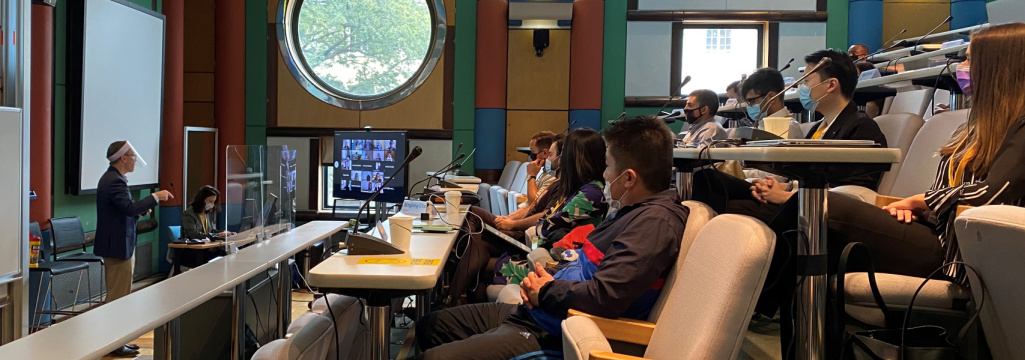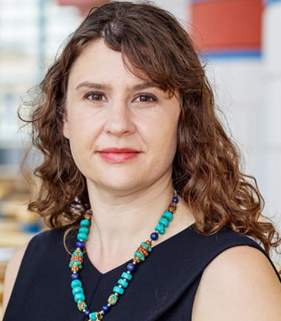
How does the last year bring us closer together?
Six months ago we, like so many other educational institutions across the globe, had to make the change to complete online delivery. We embraced the technology and delivered not one but two online residential weeks on the Masters in Entrepreneurship programme.
For us, like so many, this online form of delivery has become almost normal. The clearing of the throat at the beginning of every session “can everyone hear me” to the waving at the end of every meeting – I mean when did you ever wave at the end of a meeting before – to the regular unintended and endearing addition of children, pets and background building noise. We have seen the edges of our personal lives and work lives blur.
This year has been a year unlike any other in terms of adaptation. In the background this has also been a year of unrest in the face of environmental uncertainty and the reminder of how prevalent racism remains in our societies across the world.
Often during times of upheaval, we are reminded as a society that we are not so different after all. In 1918 the fourth reform act gave women over the age of 30 and expanded the right to vote for men over the age of 21 (whether they owned property or not). The home secretary of the time George Cave said in introducing the act “War by all classes of our countrymen has brought us nearer together, has opened men’s eyes, and removed misunderstandings on all sides”.
The question I found myself asking, as we return back into the classroom was not one of how do we deal with this latest technological challenge but “how, given everything that has happened, does the last year bring us nearer together?” And as I reflect on our first residential back in the classroom, I am amazed at what people are capable of, and how much good can come from change, but I am also reminded how much effort it takes to truly cement new routines.
Last week for the first time we returned to having students in-person, here in the business school. Students listened and took part in lectures and discussions. They networked and worked in teams. Yet, only half of these students were physically here. It was not possible for many people to make it here. This was expected. We had made the decision earlier in the summer, that we would deliver the residential synchronously to those who were here in-person and to those who were online. And so, listening, participation, discussions, networking and teamwork carried on across the boundaries of in-person and online. Yes, of course it was technologically more elaborate than either completely online or completely in-person. It was not the easy path. Yet, we wanted to leverage all of the diversity, hear all of the voices and to be one cohort. The first residential of the programme is a tremendously integral part of defining who we are as a team, a cohort, but also who we each one of us is, as individuals.
The results were impressive. There were doubts, and of course, we had technological issues, but we have a group of students who want to experiment with us, they want to be a part of creating a new experience, to find a way to do things better. So, students provided instant feedback, and they accommodated the sound going out as a new camera angle was attempted. Together, we learned how to handle this new mode of delivery. And, we all benefited from this.
As the week rolled on, and I watched the whole experience unfold, I noted how impressive our adaptations to the ongoing situation were—from all parties, students, faculty and staff alike. At the same time, I recognised how easily we slip back to comfortable routines. We want to stick to known behaviours. Thus, where there was little precedent, things seemed to stick. In-person students consistently used their push-to-talk microphones so students online could hear them. The greater struggle was correcting behaviours around the more mundane elements of a residential – drinking coffee, walking from a to b, leaning in to talk to someone, wearing masks and keeping a distance. Behaviours that normally we don’t question and just do, suddenly required all of us who were here in-person to take a step back. We needed to remember not to lean in to ask someone a question, to ponder the action of drinking coffee and to remember to put back on a mask. These actions were the tough part. The first day, the desire to just carry on as before was strong. However, when surrounded by a group that is all trying to adapt, and putting forth a conscious effort, I found that even these activities were starting to come easier. Dare I say they were becoming increasingly natural.
This past year has forced us to change our behaviour. For many of us this has required us to experiment with new routines. I also hope these past months have helped us to recognise just how many things we still take for granted that need to change. There are systematic inequalities deeply embedded within our society. To address these requires a concerted conscious effort. We should realise, now more than ever, that we can do this, if we try.
Three things we have learnt on the MSt in Entrepreneurship:
“Birds of a feather”
In the classroom, too often, we observe how individuals from similar backgrounds tend to gravitate to each other. It is natural behaviour, when placed in a new environment we naturally move to what we know; a familiar space. As we have embraced more online teaching, we have observed how webinars have served to disrupt this behaviour. By randomly assigning individuals to teams, our students mixed to a much greater extent than they had done naturally. This built much richer peer to peer learning and allowed for a greater level of support within the cohort and across all demographic groups.
In my research on the role of gender in entrepreneurship, I have seen first-hand the way that homophily plays out. Looking at the Cambridge Cluster if you look at the links between previously successful founders and the ventures they go on to mentor, often individuals choose to mentor individuals just like themselves, so it means a lot of men supporting the next generation of male entrepreneurs. In any organization we need to look into ways to disrupt the desire to gravitate to the known, to facilitate networking between those who do not naturally gravitate to each other.
Diversity of role models
Our programme involves seminars, lectures and workshops given by many practitioners. Prior to the shift to online teaching, these speakers were local “enough” in that they were willing to come to Cambridge to offer their session. Naturally, this limited the diversity of the speakers. During the virtual residentials we decided that since we were no longer geographically limited, we should expand our net to speakers from across the globe. This made me realise how we have too often engaged with people in certain industries or certain topics, but we had not taken a step back to look at the diversity of the role models we were presenting to our students. Now, our wider reach has allowed us to present a broader range of individuals, which presents students with a richer set of characteristics and behaviours to observe in terms of how entrepreneurship is accomplished. As we continue to build a culture that embraces all individuals (did I mention we have 36 nationalities represented, 38% women, and ages ranging from <25 to >55).
As we grow up we often look up to, and seek to replicate the behaviours of, role models. They have a great influence on our future aspirations. We look to people who are like us. If we don’t see people fulfilling certain roles, then we are much less likely to aspire to those roles. This continues throughout our lives. Not only do we aspire to certain jobs, but also to certain behaviours. This issue plays out too often in entrepreneurship, in terms of the role models who are seen by many people and the characteristics and behaviours they display. Throughout our adaptation to online teaching we have taken on a broader set of speakers, and we will keep it this way long after, we return to (more) in-person teaching. It is not just about having a diverse group of students but also having diverse cases. If diversity is built into a culture it becomes the norm.
We don’t just lecture
The experiments we have conducted throughout the past 6 months were possible, and a direct result of the values embodied within the programme’s community of students, staff and faculty. Our students are not solely participants. They are by no means passive, and neither are we. We are here to teach and support students and to improve the way we do this. This cannot be accomplished solely by standing in front of a lecture room or a camera and delivering the same monologue. Rather, it happens when we engage with our students in matters beyond the academic content. It happens when we recognise our own vulnerabilities as a programme. It happens when we seek advice. When things didn’t work, our students let us know, and we would do our best to fix it. There is no way we would have been where we are without this type of relationship. Even as some things may return to normal, we always need to ask questions and seek solutions from our entire community. This is especially true for any leader who seeks to build a more diverse organization, as we are doing. We cannot assume we have the answers. We must experiment and include questions and answers from those at all levels.

About Monique Boddington
Dr Monique Boddington is a Research Associate at the Entrepreneurship Centre and Interim Deputy Director of the Master of Studies in Entrepreneurship programme at Cambridge Judge Business School.


Leave a Reply